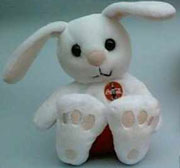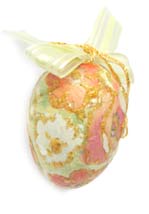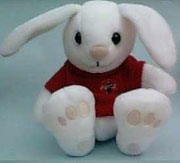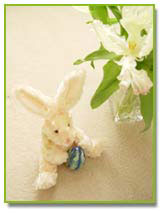|
 Easter traditions and symbols are well known: the Easter Bunny and Easter eggs have becomehallmarksof this spring festival. Easter traditions and symbols are well known: the Easter Bunny and Easter eggs have becomehallmarksof this spring festival.
 The Easter Bunny The Easter Bunny
Of all the symbols of Easter, none is more beloved than the EasterBunny.
The Easter Bunny is not a modern invention. The symbol originated with the pagan festival ofEostre, the goddess who was worshipped by the Anglo-Saxons through her earthly symbol—the rabbit.
The Germans brought the symbol of the Easter rabbit to America. It was widely ignored by other Christians until shortly after the Civil War. Christians until shortly after the Civil War.
 The Easter Egg The Easter Egg
The egg, long a symbol of fertility, had long been a traditional staple of Easter celebrations.
In the earliest times, eggs were often wrapped in gold leaf or, if you were a peasant, colored brightly by boiling them with the leaves or petals of certain flowers.
Today, children hunt colored eggs and place them in Easter baskets along with the modern version of real Easter eggs -- those made of plastic or chocolate candy.
**Easter Eggs Around the World
 It is known that the eggs were painted with bright colors to celebrate spring. It is known that the eggs were painted with bright colors to celebrate spring.
The Greeks dye their Easter Eggs red to symbolize and honor the blood of Christ, while those in Germany and Austria, traditionally give green eggs on Holy Thursday—the day commemorating Christ's Last Supper.
In Slavic countries, decorating eggs in special patterns of gold and silver adds luster to the shell and to the sharing.
The Armenian tradition is to decorate hollowed out eggshells with religious images significant to the holiday.
**Easter Games(The Easter Egg hunt, Pace Egg Play)
 The Easter Egg hunt itself has also taken many cultural twists and turns. In America, of course, the colored Easter Eggs are hidden and then children search for them. The Easter Egg hunt itself has also taken many cultural twists and turns. In America, of course, the colored Easter Eggs are hidden and then children search for them.
In the northern counties of England, children act out the "Pace Egg Play" and beg for eggs and other presents; the term Pace itself is a derivative of the ancient Hebrew verb posach (to pass over), which has evolved into the better known word and holiday title Pesach, or Passover.
Pennsylvania Dutch children believed that if they were good, theOschter Hawswould lay a nest of brightly colored eggs.
And, in a far-removed invocation of the egg's primal symbol—fertility—Polish girls used to send eggs to their beloveds as a token of their feelings.
** Other Easter symbols(the cross, lily, lamb, pussy willows)
 The cross and the lily are both Christian symbols relating to the religious significance of the season and the renewal of faith. The cross and the lily are both Christian symbols relating to the religious significance of the season and the renewal of faith.
Similarly, the lamb has a religious basis in Christianity (Christ as the Good Shepherd) . The view of a lamb as a symbol of new life is the foundation for this religious images.
A unique Easter tradition founded primarily in England and Russia is the picking ofpussy willows. As an ancient symbol that spring had finally arrived, it was viewed as good luck to be tapped on the shoulder by a branch of these soft blooms by a neighbor or loved one.
(英语点津陈蓓编辑)
|